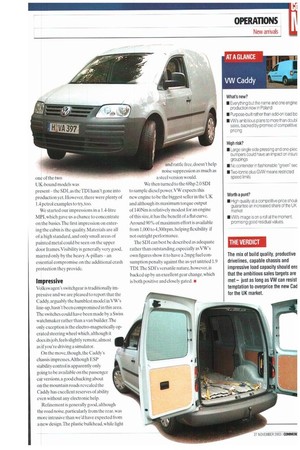CADDY COOL?
Page 54

Page 55

If you've noticed an error in this article please click here to report it so we can fix it.
Volkswagen's third-generation Caddy still uses components from the latest VW Golf, but this time around the van's a purpose-built machine.
Welcome to the third chapter in a story that, amazingly,spans four decades. It was 1979 when the Golf Mkl-based Rabbit Pick-up was launched in the US.Three years later, it came to Europe wearing the Caddy badge. It continued in this form until 1992, when the Sarajevo factory was destroyed during the Bosnian war.
A replacement arrived in 1995, this time built in Spain and largely Polo based—and with a high-cube van body for the first time. The van quickly outsold the pick-up, which was dropped in 2000.
The third-generation Caddy, now built at Poznan in Poland and due in Europe next spring, is based on the recently launched Golf Mk5 and new Touran compact MPV. But apart from thc fundamental platform and frontal bodywork synergies, the loadcarrying part of the new Caddy is a fully integrated design, doing away with the 'stuck-on box' approach of its predecessor.
Although the range includes petrol power, the UK will only get two diesel versions — four-cylinder, two-valve units featuringVW's Pumpe Diise unit injection. Although it's the lower powered, the naturally aspirated SDI powerplant is the more modern engine. It is part of VW's new family which will be available in two and four-valve, naturally aspirated and turbo-charged versions. What's more, when Euro-4 compliant engines are added,VW reckons they will include naturally aspirated versions, a feature which had at one stage been thought unachievable. Meanwhile. the TIDI is the manufacturer's proven chargecooled unit with variable-geometry turbo.The SDI and TDI are both to feature a five-speed manual transmission at launch, although the latter is to offer an automatic option in 2005.
There is one body style,available as a 3.2m' van or a Kombi passenger carrier, eventually with seven seats.A single sliding side door and asymmetrically split rear barn doors are standard, while a tailgate and second sliding door are optional, as is the deletion of the first one. A long-load roof hatch will be available later. In-cab storage is well provided, and includes non-slip multi-compartment dash-top trays, an overhead shelf, and under-seat drawers. The international press launch of the new Caddy, in the Black Forest countryside around Freiburg, offered extensive driving opportunities of the new range, although only one of the two UK-bound models was present — the SD I. as the TDI hasn't gone into production yet. However, there were plenty of 1.4 petrol examples to try, too.
We started our impressions in a 1.4-litre MPI, which gave us a chance to concentrate on the basics.The first impression on entering the cabin is the quality. Materials are all of a high standard.and only small areas of painted metal could be seen on the upper door frames. Visibility is generally very good, marred only by the heavy A-pillars — an essential compromise on the additional crash protection they provide.
Impressive Volkswagen's switchgear is traditionally impressive and we are pleased to report that the Caddy, arguably the humblest model in VW's line-up, hasn't been compromised in this area. The switches could have been made by a Swiss watchmaker rather than a van builder.The only exception is the electro-magnetically operated steering wheel which, although it does its job, feels slightly remote, almost as if you're driving a simulator.
On the move, though, the Caddy's chassis impresses. Although ESP stability control is apparently only going to be available on the passenger car versions, a good chucking about on the mountain roads revealed the Caddy has excellent reserves of ability even without any electronic help.
Refinement is generally good, although the road noise, particularly from the rear, was more intrusive than we'd have expected from a new design.The plastic bulkhead, while light and rattle free.doesn't help noise suppression as much as a steel version would.
We then turned to the 68hp 2.0 SDI to sample diesel power. VW expects this new engine to be the biggest seller in the UK and although its maximum torque output of 140Nm is relatively modest for an engine of this size, it has the benefit of a flat curve. Around 90% of maximum effort is available from 1.000 to 4,300rpm. helping flexibility if not outright performance.
The SDI can best he described as adequate rather than outstanding, especially as VW's own figures show it to have a 2mpg fuel consumption penalty against the as-yet untried 1.9 TDI.The SDI's versatile nature, however, is backed up by an excellent gear change. which is both positive and closely gated. •


























































































































































































